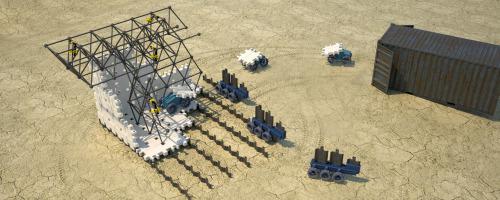当前位置:
X-MOL 学术
›
Autom. Constr.
›
论文详情
Our official English website, www.x-mol.net, welcomes your
feedback! (Note: you will need to create a separate account there.)
On-site autonomous construction robots: Towards unsupervised building
Automation in Construction ( IF 9.6 ) Pub Date : 2020-11-01 , DOI: 10.1016/j.autcon.2020.103312 Nathan Melenbrink , Justin Werfel , Achim Menges
Automation in Construction ( IF 9.6 ) Pub Date : 2020-11-01 , DOI: 10.1016/j.autcon.2020.103312 Nathan Melenbrink , Justin Werfel , Achim Menges

|
Abstract Real-world construction projects typically require three groups of tasks: site preparation (earthmoving, leveling), substructure (anchoring, foundations), and superstructure (load-bearing elements, facade, plumbing, wiring, etc.). Advances in construction automation have revealed a gap between industry and academic research, where industry efforts have been focused on automating conventional earthmoving equipment and embracing prefabrication in order to reduce the amount of work that needs to be done on site, while academic efforts have largely concentrated on proposals for on-site additive manufacturing or discrete assembly, which may be of limited applicability to industry. This review presents a broad range of advancements in construction automation research, and finds that achieving fully autonomous construction in unstructured environments will require considerably more development in all three groups of construction tasks, as well as a particular emphasis on coordinating myriad construction tasks between different task-specific robots. Consideration is given to both mature technologies (conventional equipment widely used in industry) and emerging technologies (novel machines designed for autonomy). Key findings from the survey suggest that achieving the goal of fully autonomous construction will require more attention to be paid to site preparation and substructure tasks, material-robot systems (co-designed robots and building materials), embedded sensing, auxiliary construction tasks, and coordinating operations between robot systems. More general lessons from the literature indicate that making incremental improvements to mature technologies may benefit the industry in the short term, but there are considerable limitations to adding autonomy to equipment designed for human operators. Instead, we perceive a demand for novel hardware to be developed for specific tasks, in each case based on fundamental principles and at the appropriate scale, as well as for an increase in interdisciplinary research. We suggest that the reported shortage of skilled labor in the industry can be met with an increased emphasis on training for leveraging advances in automation.
中文翻译:

现场自主施工机器人:走向无人监督的建筑
摘要 现实世界的建筑项目通常需要三组任务:场地准备(土方、平整)、下部结构(锚固、基础)和上部结构(承重元件、立面、管道、布线等)。建筑自动化的进步揭示了行业和学术研究之间的差距,行业的努力主要集中在传统土方设备的自动化和采用预制以减少需要在现场完成的工作量,而学术努力主要集中在关于现场增材制造或离散组装的建议,这可能对工业的适用性有限。这篇综述介绍了建筑自动化研究的广泛进展,并发现在非结构化环境中实现完全自主的施工将需要在所有三组施工任务中进行更多的开发,并且特别强调在不同任务特定机器人之间协调无数的施工任务。既考虑成熟技术(工业中广泛使用的常规设备),也考虑新兴技术(为自主设计的新型机器)。调查的主要发现表明,实现完全自主施工的目标需要更多地关注场地准备和下部结构任务、材料机器人系统(协同设计的机器人和建筑材料)、嵌入式传感、辅助施工任务以及协调机器人系统之间的操作。文献中更普遍的经验表明,对成熟技术进行渐进式改进可能会在短期内使该行业受益,但为人类操作员设计的设备增加自主性存在相当大的局限性。相反,我们认为需要为特定任务开发新硬件,在每种情况下都基于基本原则和适当的规模,以及增加跨学科研究。我们建议,可以通过更加重视利用自动化进步的培训来解决所报告的该行业熟练劳动力短缺的问题。我们认为需要为特定任务开发新的硬件,在每种情况下都基于基本原则和适当的规模,以及增加跨学科研究。我们建议,可以通过更加重视利用自动化进步的培训来解决所报告的该行业熟练劳动力短缺的问题。我们认为需要为特定任务开发新的硬件,在每种情况下都基于基本原则和适当的规模,以及增加跨学科研究。我们建议,可以通过更加重视利用自动化进步的培训来解决所报告的该行业熟练劳动力短缺的问题。
更新日期:2020-11-01
中文翻译:

现场自主施工机器人:走向无人监督的建筑
摘要 现实世界的建筑项目通常需要三组任务:场地准备(土方、平整)、下部结构(锚固、基础)和上部结构(承重元件、立面、管道、布线等)。建筑自动化的进步揭示了行业和学术研究之间的差距,行业的努力主要集中在传统土方设备的自动化和采用预制以减少需要在现场完成的工作量,而学术努力主要集中在关于现场增材制造或离散组装的建议,这可能对工业的适用性有限。这篇综述介绍了建筑自动化研究的广泛进展,并发现在非结构化环境中实现完全自主的施工将需要在所有三组施工任务中进行更多的开发,并且特别强调在不同任务特定机器人之间协调无数的施工任务。既考虑成熟技术(工业中广泛使用的常规设备),也考虑新兴技术(为自主设计的新型机器)。调查的主要发现表明,实现完全自主施工的目标需要更多地关注场地准备和下部结构任务、材料机器人系统(协同设计的机器人和建筑材料)、嵌入式传感、辅助施工任务以及协调机器人系统之间的操作。文献中更普遍的经验表明,对成熟技术进行渐进式改进可能会在短期内使该行业受益,但为人类操作员设计的设备增加自主性存在相当大的局限性。相反,我们认为需要为特定任务开发新硬件,在每种情况下都基于基本原则和适当的规模,以及增加跨学科研究。我们建议,可以通过更加重视利用自动化进步的培训来解决所报告的该行业熟练劳动力短缺的问题。我们认为需要为特定任务开发新的硬件,在每种情况下都基于基本原则和适当的规模,以及增加跨学科研究。我们建议,可以通过更加重视利用自动化进步的培训来解决所报告的该行业熟练劳动力短缺的问题。我们认为需要为特定任务开发新的硬件,在每种情况下都基于基本原则和适当的规模,以及增加跨学科研究。我们建议,可以通过更加重视利用自动化进步的培训来解决所报告的该行业熟练劳动力短缺的问题。











































 京公网安备 11010802027423号
京公网安备 11010802027423号